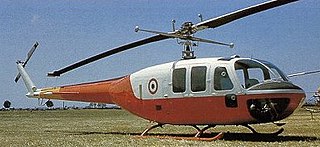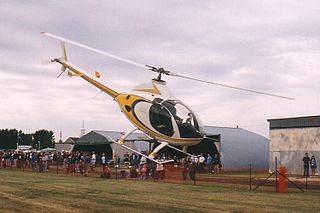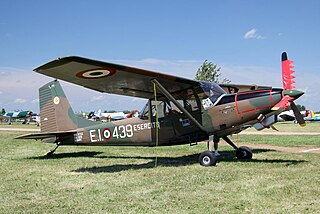
The PZL Kania is a follow-up to the Mil Mi-2 helicopter, developed in Poland by PZL-Świdnik.
The Aerospace General Mini-Copter was a miniature helicopter designed to be air-dropped to U.S. military pilots stranded behind enemy lines or in otherwise inaccessible areas.

The Aerotécnica AC-12Pepo was a Spanish two-seat light helicopter of the 1950s by Aerotécnica.

The Aerotécnica AC-14 was a Spanish five-seat light helicopter of the 1950s, designed by Jean Cantinieau, based on enlarging his Nord Norelfe design.

The Agusta A.101 was a large prototype transport helicopter developed in Italy during the 1960s. Despite prospective orders from the Italian armed forces, no buyers emerged and the project was abandoned in 1971.

The Agusta A.103 was an Italian prototype single-seat light helicopter flown in October 1959. The pilot was enclosed by a perspex bubble with the engine at the rear and the tail rotor carried on an enclosed boom.

The Agusta AB.102 was an Italian helicopter produced in small numbers in the early 1960s. The aircraft was based on the mechanical components of a Bell 48 that Agusta incorporated into an all-new, streamlined fuselage. The first flight was on 3 February 1959 and the prototype was exhibited at that year's Paris Air Show in faux military colours. Only two production examples were built, operated by Elivie in a regular air service between Turin and Milan from 1961. However, the advent of turbine-powered helicopters in the 1960s soon rendered the AB.102 obsolete.
The AISA GN was a prototype four-seat autogyro developed in Spain between 1971 and 1982. it featured an extensively-glazed cabin fitted with a pusher engine and tricycle undercarriage. A separate tail fin was carried at the end of two booms mounted to stub wings. The prototype was developed with a 200 hp engine. The aircraft suffered from an extremely prolonged development, but finally took to the air on 20 July 1982. Shortly thereafter, however, it was damaged and finally abandoned.

The RotorWay Exec is a family of American two-bladed, skid-equipped, two-seat kit helicopters, manufactured by RotorWay International of Chandler, Arizona and supplied in kit form for amateur-construction.

The Fokker F.25 Promotor, first flown in 1946, was a single-engined, twin-boomed, four-passenger monoplane with a pusher engine mounted at the rear of a central nacelle. It was of wooden construction and has fitted with a retractable nosewheel undercarriage. One feature of the design was that instead of a 2 + 2 seating, the pilot sat in front to the left, and all three passengers were on a bench seat to the rear of him. Alternatively, when being used as an air ambulance aircraft, it could carry a patient on a stretcher, which was loaded through a hatch in the aircraft's nose. The F.25 was evocative of the pre-war G.I design. The F.25 was based upon the design of the Difoga 421 aircraft, home-built and -designed during World War II by Frits Diepen, a Ford garage owner from Tilburg, the Netherlands. His intention was to create an easy to fly personal aircraft. Due to the war an aircraft engine was not available and instead it used a Ford V-8.

The Cicare CH-14 Aguilucho is a light experimental helicopter manufactured by Cicaré Helicópteros of Argentina. The helicopter is intended for use in civil, security and military roles.
The Eagle Helicopter Eagle II and Eagle III were light helicopters developed in the United States in the early 1980s. With side-by-side seating for two, they had an unusual boxy fuselage shaped like a stubby wedge. No anti-torque system was required, since the rotors of both aircraft were powered by tip jets. In the case of the Eagle II, the tip jets were "cold", fed with compressed air generated by an Evinrude piston engine, while the Eagle III's rotor was driven by more conventional propane-burning jets. Development did not progress beyond the construction of a prototype in each configuration.

The SIAI-Marchetti SM.1019 is an Italian STOL liaison monoplane built by SIAI-Marchetti for the Italian Army, and based on the Cessna O-1 Bird Dog.

The IAR-827 was an agricultural aircraft built in Romania in the 1970s and 1980s. The penultimate member of the family of designs that began with the IAR-821, it was, like the others, a conventional low-wing monoplane with fixed, tailwheel undercarriage, and shared the all-metal construction of the IAR-826. The prototype flew in 1976, powered by a Lycoming IO-720 engine, but the production examples that followed all had the PZL-3S.
The Kamov Ka-118 is a projected light multirole helicopter with the NOTAR configuration based on the McDonnell Douglas design.

The Wassmer WA-80 Piranha is a French two-seat low-wing cabin monoplane trainer designed and built by Société Wassmer. Based on the same construction as the company's WA-50 four-seater, the WA-80 was a scaled down version. The prototype, registered F-WVKR, first flew in November 1975 powered by a 100 hp Rolls-Royce Continental O-200 engine. Wassmer appointed a receiver and suspended production in 1977 after 25 had been built.
The Zenair Mono-Z CH 100 is a single-seat, single-engined Canadian light aircraft of the 1970s. It is a smaller version of the Zenair CH 200 with a less powerful engine, which was sold as a homebuilt aircraft by Zenair.
The Ekin WHE Airbuggy is a British single-seat autogyro designed and built by the W. H. Ekin (Engineering) Company in Northern Ireland.
The RotorWay Helicopter Manufacturing Company, formerly called RotorWay International, is a manufacturer of kit helicopters located in Chandler, Arizona, United States. The company was founded by B.J. Schramm in 1961 as RotorWay Aircraft. RotorWay International was bought February 14, 2007 by a small group of investors comprising the company's upper-level management – Grant Norwitz, CEO, Bill Adams, COO, and Judy Craven, CFO. Of these, only Norwitz was still with the company in mid-2008.
The Hillberg EH1-01 RotorMouse is an American helicopter that was designed by Donald Gene Hillberg and produced by Hillberg Helicopters of Fountain Valley, California, first flying in 1993. Now out of production, when it was available the aircraft was supplied as a kit for amateur construction.













